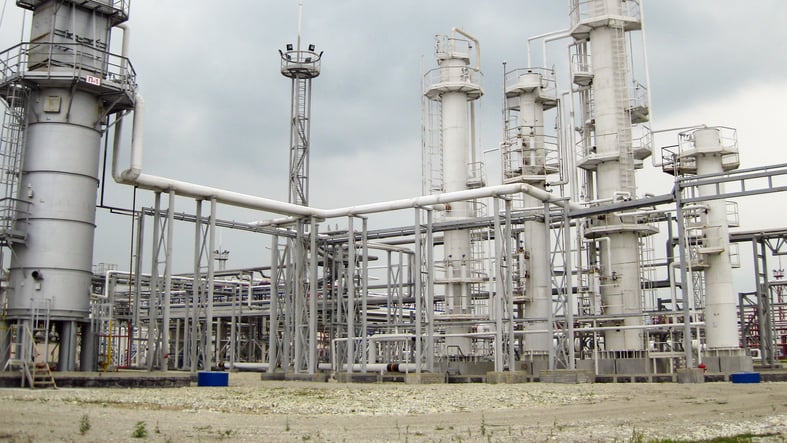
You’ve probably been warned about building with dissimilar metals such as carbon steel and stainless steel; there’s good reason. This mistake has been the cause of major catastrophes, like the Santa Barbara oil spill.
Still, you don’t have to avoid this metallic combination altogether. We’re here to help you understand how to do it the right way.
Read on for a simple breakdown of galvanic corrosion and how to prevent corrosion between carbon and stainless steel.
What Is Galvanic Corrosion?
For this corrosion to start, there need to be three things: an anode (one metal), a cathode (a second metal), and an electrolyte (water is a common one).
Some metals are more likely to give their electrons away, and others are more eager to pull in extra electrons. That means combining these different types of metals in electrolyte-heavy environments causes one metal to hand its electrons over to the other.
When a metal gives away electrons, galvanic corrosion starts, and the metal rusts.
How Does Galvanic Corrosion Happen?
When two dissimilar metals are connected to each other, the electrolyte helps move one metal’s electrons to the other metal. As the electron-generous metal loses electrons, it undergoes oxidation.
Oxidation causes the metal to rust, weaken, and disintegrate. The result is a corrupted metal piece and a weakened pipe, beam, or structure.
Carbon Steel vs. Stainless Steel: What’s the Difference?
Not all steel is the same. In fact, some steels don’t get along well together. This can be the case with carbon steel and stainless steel.
What’s the difference between these two common types of steel?
Carbon Steel
Carbon steel and stainless steel are both iron-based metals, but carbon steel has an especially high content of carbon. This makes carbon steel notably strong, heavy, and hard.
However, carbon steel is vulnerable to corrosion. That’s because it’s made of iron, and it’s easy for oxygen to corrupt iron. The result is iron oxide, or rust, which can completely eat away at carbon steel.
Stainless Steel
You might be thinking, “Wait, if both steels are iron-based, why is stainless steel resistant to corrosion?”
Stainless steel has a secret weapon: chromium.
Chromium can shrug off oxygen without corroding. The addition also pushes stainless steel higher up on the nobility chart.
So when stainless steel and carbon steel are connected, and an electrolyte such as moisture is introduced, stainless steel absorbs carbon steel’s electrons. Carbon steel can deteriorate rapidly, become weak, and come crashing down.
How to Prevent Corrosion Between Carbon and Stainless Steel
Despite not getting along, both carbon steel and stainless steel are strong and useful. Luckily, there are some ways to help them work in tandem without causing corrosion:
Use a Buffer
If the two types of steel can’t play nice, we might as well separate them. How? For piping, you can install things such as pipe shoes or wear pads. You can also add clamp liners or all kinds of insulators, like ProTek rods or flat plates.
These supports reinforce piping and keep metals from rubbing against one another.
They also help stabilize structures, which cuts down friction, makes cracks less frequent, and makes it harder for corruptive electrolytes to slip into metals.
Other buffers, such as nylon washers or fasteners, can add a protective layer between dissimilar metals in bolts or support beams, too.
Plate the Carbon Steel
Galvanizing is a way to protect carbon steel without completely changing its structure. When carbon steel is galvanized, a layer of zinc is spread over its surface.
Zinc is much lower on the galvanic scale than carbon steel, which means it’s more basic and more likely to give up its electrons than carbon steel.
After galvanizing, zinc sacrifices its electrons anytime a corrosive metal connects with the surface. Thus, the carbon steel structure can retain its sturdy form.
Reduce Exposure to Electrolytes
Remember, for galvanic corrosion to start, there need to be two metals and an electrolyte. So keeping electrolytes at bay can slow corrosion.
Some good options are to add aeration or smooth out surfaces whenever it’s possible. Waterproofing by adding water-resistant coatings can go a long way toward preserving metals, and you can use sealants to stop water or gunk from sliding between crevices.
It’s also a good idea to add drainage to avoid stagnant water. Pooling water erodes sections of metal and kick-starts the corrosion process. A good way to add drainage is through weep holes. This is where you drill holes in the bottom of hollow supports to give water an escape route.
More on Preventing Corrosion
Corrosion can be a scary hazard on a work site or in existing structures. However, knowing how it works will help you take the right actions to stop it. Download The Expert's Guide to Hot-Dip Galvanization to learn more.






